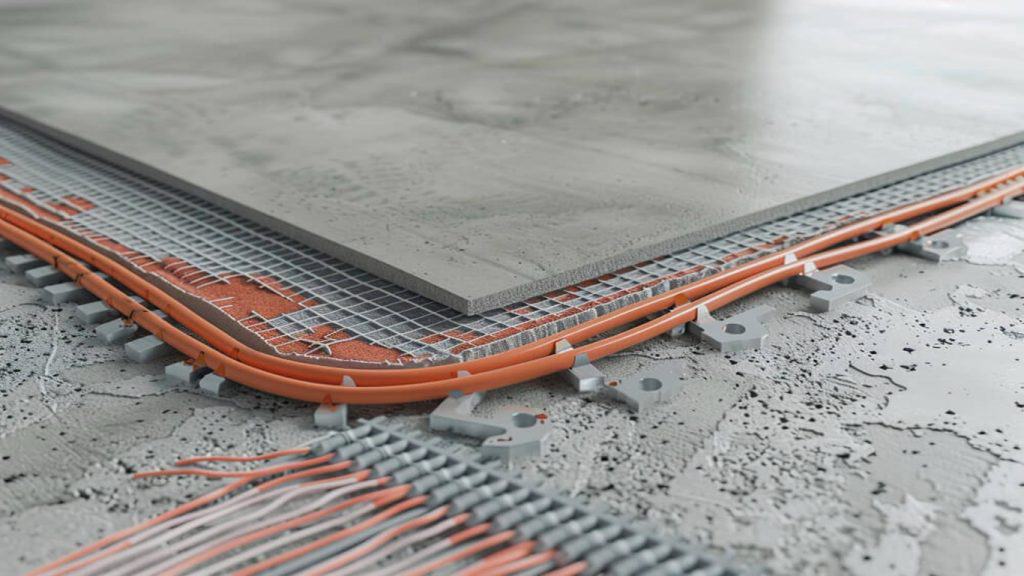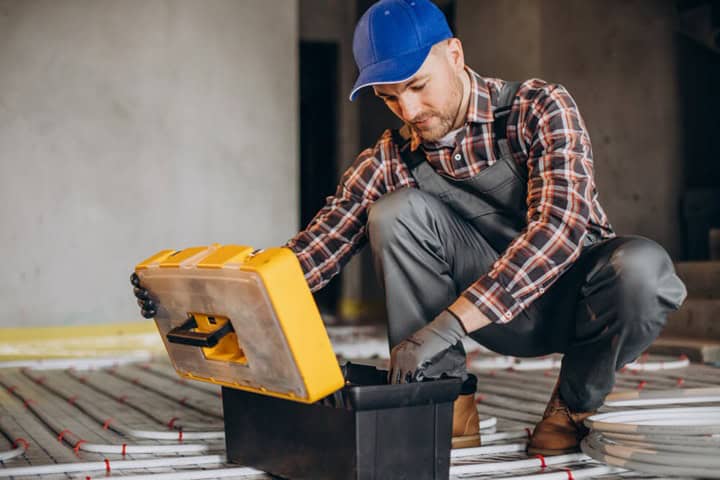
Are you waiting too long for your underfloor heating to warm up? Understanding the heating process can significantly cut down your waiting times.
Knowing how long it takes for underfloor heating to warm up is one of the biggest deciding factors for those wishing to purchase underfloor heating for their homes and other relevant structures. In this article, we will thoroughly answer – how long does underfloor heating take to warm up – by narrowing down what obstacles may prevent your underfloor heating kit from warming up a lot sooner.
Key points:
- How underfloor heating systems work and their components.
- Key factors affecting heat-up times, including insulation and floor materials.
- Strategic management tips to reduce heating times.
- The impact of room size and ambient temperatures on warming efficiency.
- Practical tips for optimising your underfloor heating setup for comfort and cost-effectiveness.
Understanding Underfloor Heating Warm-Up Times
Underfloor heating systems offer a sleek and efficient way to heat your home, but many homeowners have questions about how long does underfloor heating take to warm up…
How Underfloor Heating Systems Operate
Underfloor heating systems mainly have two different types, but both work under the same principle of distributing radiant floor heating. Whether you have a water-based (hydronic) system or an electric underfloor heating system, the idea is the same: heat is evenly distributed from the floor, making it one of the most comfortable and efficient heating methods available compared to other central heating systems.
Factors that might impact underfloor heating warm-up times:
- Floor construction
- Level of insulation
- Type of floor finish
- Ambient temperature
1. Insulation
Good insulation is crucial for effective underfloor heating. Well-insulated homes retain heat better, allowing the underfloor system to reach and maintain the desired temperature more efficiently.
High-quality floor insulation prevents heat from seeping downward, speeding up the warm-up process and reducing energy consumption. It is especially relevant for mobile home insulation as well.
2. Floor Covering
The type of flooring under which the heating system is installed plays a significant role in how quickly the heat will permeate the space above.
Materials like tile and stone are excellent conductors, often warming up within 30 to 60 minutes.
In contrast, thicker materials like hardwood and carpets can significantly slow down the heating process, sometimes taking up to a few hours to feel warm to the touch.
For specific information regarding flooring, try these articles:
- Laminate flooring for underfloor heating
- Porcelain or ceramic tiles
- Rug vs carpet
- Best flooring for underfloor heating
3. Heat Loss
Heat loss can dramatically affect how long your underfloor heating system takes to warm up. Minimising heat loss through proper insulation where heat is most likely to escape is key —like windows, doors, and walls.
Strategic installation can also reduce heat loss; for instance, increasing the loops of heating elements in areas prone to higher heat loss can enhance overall efficiency.
4. Room Size
The phrase “how long for underfloor heating to heat up” often relates directly to the size of the area being heated.
Larger rooms require more time to reach the desired temperature compared to smaller spaces. This variance is due to the volume of air and flooring that needs to be heated. To address this, many systems offer zoning capabilities, which allow you to heat different sections of your home independently. This means that living areas can be warmed according to their use and size, ensuring a more efficient heating process and a reduction in energy waste.
5. Planning Ahead
Planning ahead can significantly influence how long it takes for underfloor heating to warm up. By scheduling your heating system to activate in advance of when you’ll need the room, you can ensure it reaches a comfortable temperature right when necessary. This preemptive approach is not only about comfort but also efficiency, preventing the system from overworking itself in a short period and instead maintaining a gradual increase in temperature.
6. Managing Underfloor Heating
Maintaining an optimal warm-up time for underfloor heating isn’t just about installation but also about management:
- Maintain a Low Base Temperature: Keeping the heating on at a low level continuously during colder months can prevent the system from cooling down completely, thus reducing the time it takes to warm up when higher heat is needed.
- Smart Thermostats: Utilise smart thermostats to control and schedule your heating. These devices allow for precise temperature management throughout the day, adapting to your lifestyle and reducing overall energy usage.
- Zone Your Heating: By zoning your underfloor heating, you can control which areas of your home are heated and when. This not only improves efficiency but also ensures that spaces in use are comfortably heated when needed. You can also incorporate multi-zone heating so that numerous areas of your home can be heated at once.
Practical Tips to Improve Your Heating Experience

Here are a few tips to ensure that your underfloor heating system works efficiently, providing comfort without excessive wait times or energy bills:
- Choose the Right Flooring: Opt for materials that conduct and retain heat well to enhance the system’s efficiency.
- Insulate Effectively: Ensure your home and floors are well-insulated to prevent unnecessary heat loss.
- Plan Ahead: Use programmable settings on your thermostat to start heating your home before you need the space, allowing you to enjoy instant comfort.
- Regular Maintenance: Keep your heating system in top condition with regular checks and maintenance to avoid any inefficiencies or malfunctions.
Pros and Cons of Underfloor Heating
Heat distribution of underfloor heating is both a key contributing factor towards the pros and cons of underfloor heating, but what exactly are the other factors to consider?
Pros:
- Even Heat Distribution: Underfloor heating provides a more uniform heat distribution across the room, eliminating cold spots typically associated with radiators.
- Energy Efficiency: Because they operate at lower temperatures while still providing the same level of warmth, underfloor heating systems are generally more energy-efficient than traditional systems, potentially reducing heating bills.
- Aesthetic and Space Saving: With no radiators on the walls, underfloor heating offers a cleaner aesthetic and frees up wall space for furniture without blocking heat output.
- Improved Air Quality: These systems don’t circulate air as forced air systems do, which can reduce the movement of heat dust and allergens within the home.
Cons:
- Higher Initial Cost: The installation cost for underfloor heating can be higher than that of traditional radiators or forced air systems, especially if retrofitting in an existing home.
- Installation Complexity: Installation can be invasive, particularly for retrofit projects, requiring significant upheaval and potentially raising floor levels.
- Slower Response Time: It takes longer for underfloor heating to warm up a space compared to radiators, which might not be ideal for quick heat needs.
Underfloor Heating Support Available
As a lead supplier of underfloor heating, we are dedicated to helping customers understand and optimise the warm-up times of their underfloor heating systems. By offering expert advice and a range of high-quality products tailored to various needs, we ensure that each customer can make informed decisions about their heating solutions.
Feel free to contact us today so we can offer a bespoke quote on why your underfloor heating may be taking too long to warm up, and what solutions are available.
Underfloor Heating How Long To Warm Up Answered

In conclusion, knowing how long it takes for underfloor heating to warm up is not a one-size-fits-all answer. However, by understanding the dynamics of room size, flooring, insulation, planning ahead, and considering the specific characteristics of your heating system, you can significantly elevate both the performance and enjoyment of your underfloor heating system.
These strategies help ensure that when you step into a room, it’s already cosily warmed to your preference, effectively minimising wait times and maximising comfort, no matter whether it is a kitchen, bathroom, lounge, or other room within the home.
FAQs
Why does my underfloor heating take so long to warm up?
Underfloor heating systems typically take longer to warm up due to the large surface area they need to heat and their installation beneath floor materials which act as insulators. The type of flooring, the system’s design, and the initial room temperature can also affect the warm-up time.
Should the floor feel warm with underfloor heating?
Yes, the floor should feel warm with underfloor heating, but not uncomfortably hot. The warmth should be gentle and evenly distributed across the surface, providing a consistent temperature throughout the room.
Why is my underfloor heating not as warm?
If your underfloor heating isn’t warming as expected, possible reasons could include air in the system, issues with the thermostat, insufficient insulation, or a malfunctioning heating system. It’s advisable to check these components or consult a professional for an assessment and possible repair.
Sources
Designing Buildings. (2022) Types of Floor. [online] Available at: https://www.designingbuildings.co.uk/wiki/Types_of_floor [accessed 27/08/24]
